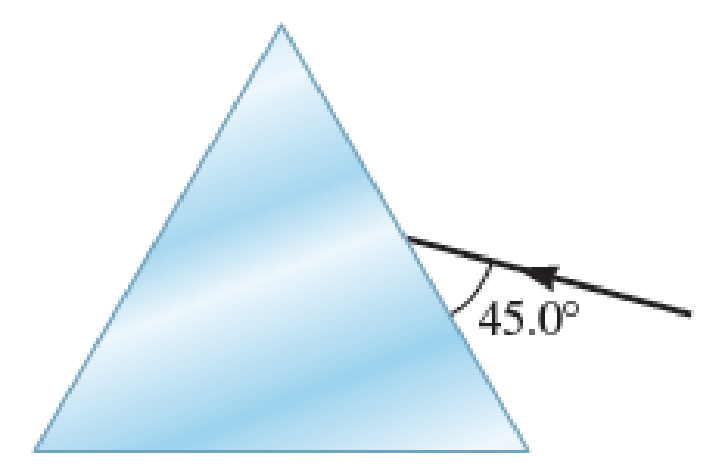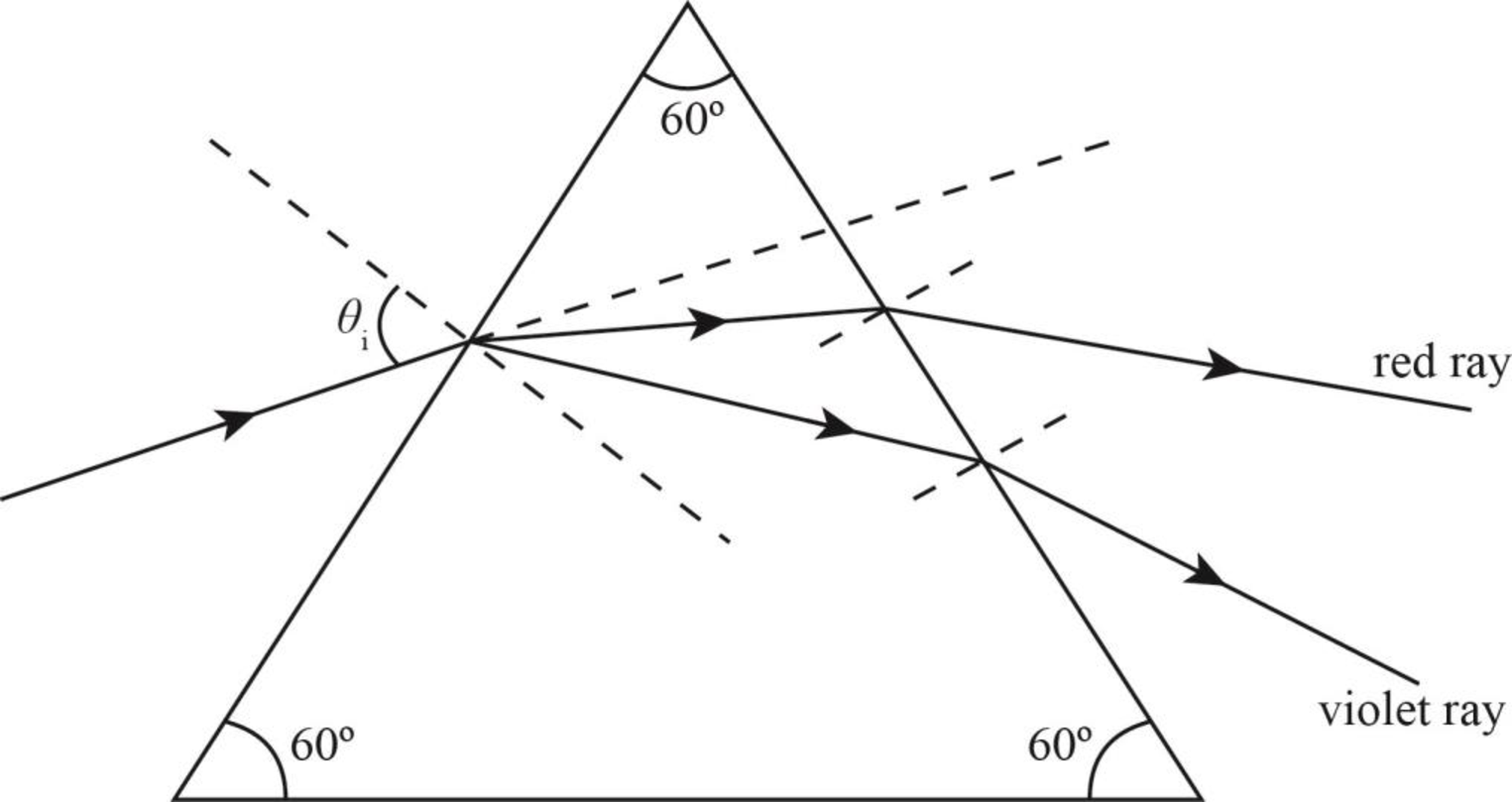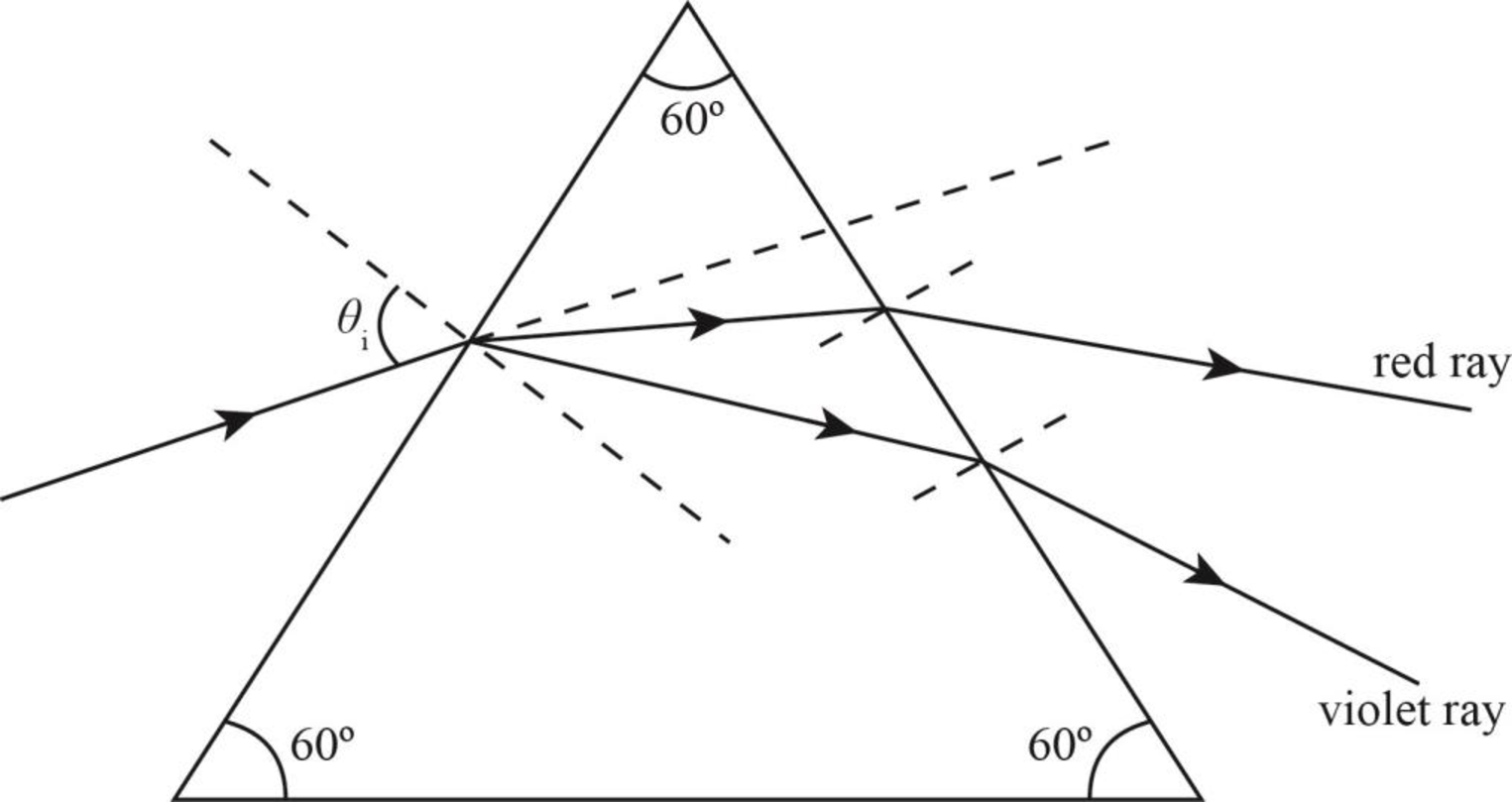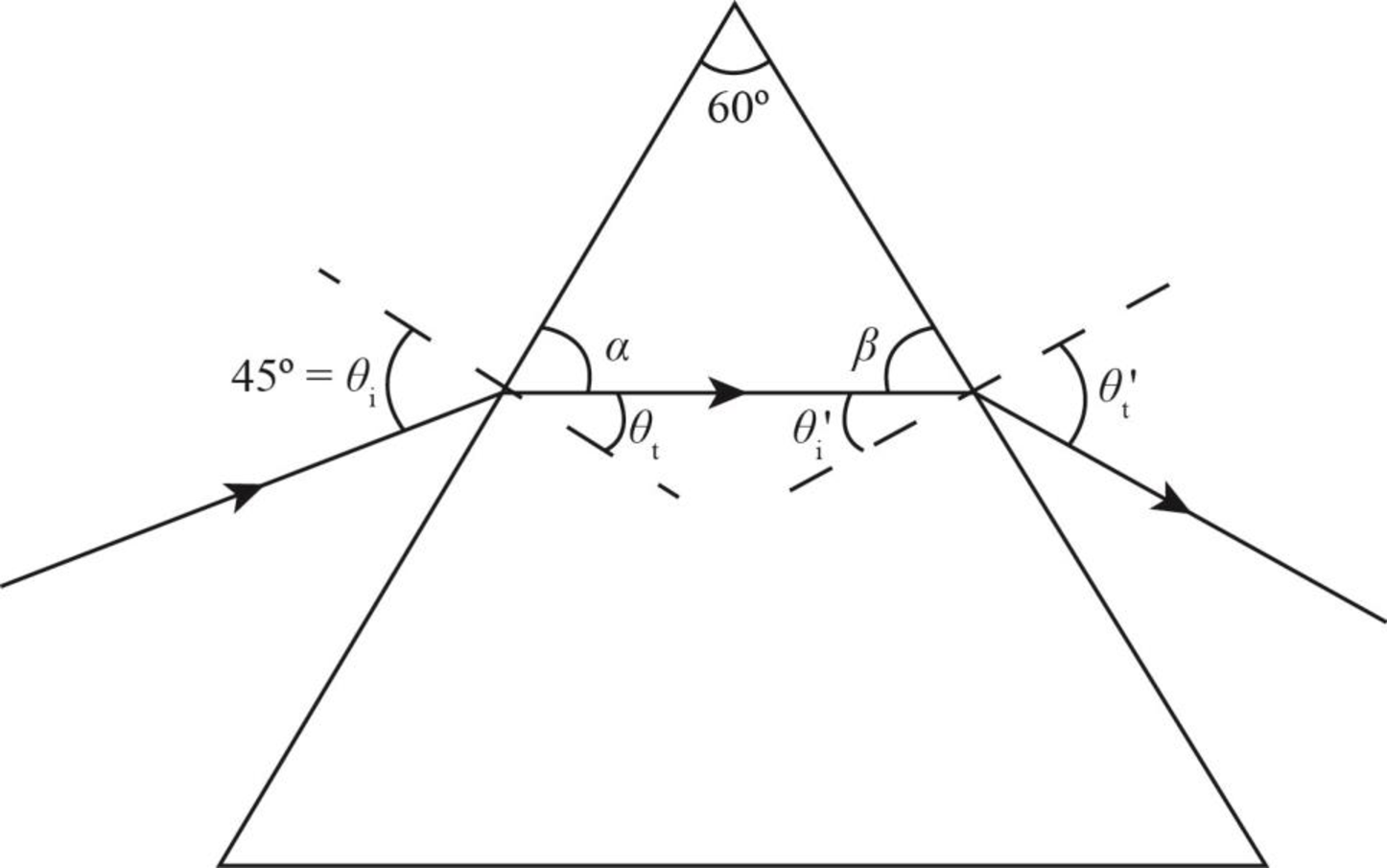
Concept explainers
Light is incident on a prism as shown in Figure P38.31. The prism, an equilateral triangle, is made of plastic with an index of refraction of 1.46 for red light and 1.49 for blue light. Assume the apex angle of the prism is 60.00°.
- a. Sketch the approximate paths of the rays for red and blue light as they travel through and then exit the prism.
- b. Determine the measure of dispersion, the angle between the red and blue rays that exit the prism.

Figure P38.31
(a)
The sketch of the appropriate path of the red and blue light rays through the prism.
Answer to Problem 31PQ
The sketch of the appropriate path of the red and blue light rays through the prism is as shown below.

Explanation of Solution
The wavelength of the violet light is 410 nm and the wavelength of the red light is 680 nm.
The wavelength of light is inversely proportion to the refractive index of the material through which it is passing.
The wavelength of the violet light is lesser than the wavelength of the red light. Hence, the refractive index of the violet light is more as compared to the refractive index for the red light.
Therefore, violet light refracts more as compared to the red light as shown in the figure below.

Figure-(1)
(b)
The dispersion angle between the red and blue rays when exit the prism.
Answer to Problem 31PQ
The dispersion angle between the red and blue rays when exit the prism is 2.64°.
Explanation of Solution
Write the expression for Snell’s law.
n1sinθi=n2sinθt
Here, incidence angle is θi, refractive index of the first medium is n1, refraction angle is θt and the refractive index of the second medium is n2.
Further solve the above equation for θt.
sinθt=n1n2sinθiθt=sin−1(n1n2sinθi) (I)
The prism diagram on which light is incident at an angle 45° is as shown below.

Figure-(1)
Write the expression for dispersion angle between the red and blue rays when exit the prism.
ϕ=(θ't)b−(θ't)r (II)
Here, dispersion angle between the red and blue rays when exit the prism is ϕ, refracted angle at the exit of the prism for blue light is (θ't)b and refracted angle at the exit of the prism for red light is (θ't)r.
Conclusion:
Case (i): For blue light.
Substitute 1 for n1, 1.49 for n2 and 45.0° for θi in equation (I) to find (θt)b
(θt)b=sin−1(11.49sin45°)=sin−1(0.474)=28.33°
Solve for α.
α=90°−(θt)b=90°−28.33°=61.67°
Solve for β.
β=180°−60°−α=180°−60°−61.67°=58.33°
Solve for θ'i.
θ'i=90°−β=90°−58.33°=31.67°
Substitute 31.67° for θ'i, 1.49 for n1 and 1 for n2 in equation (I) to find (θ'j)b.
(θ't)b=sin−1(1.491sin31.67°)=sin−1(0.782)=51.47°
Case (ii): For red light.
Substitute 1 for n1, 1.46 for n2 and 45.0° for θi in equation (I) to find (θt)b
(θt)r=sin−1(11.46sin45°)=sin−1(0.484)=28.96°
Solve for α.
α=90°−(θt)b=90°−28.96°=61.04°
Solve for β.
β=180°−60°−α=180°−60°−61.04°=58.96°
Solve for θ'i.
θ'i=90°−β=90°−58.69°=31.04°
Substitute 31.04° for θ'i, 1.49 for n1 and 1 for n2 in equation (I) to find (θ'j)r.
(θ'j)r=sin−1(1.461sin31.04°)=sin−1(0.752)=48.83°
Substitute 51.47° for (θ't)b and 48.83° for (θ'j)r in equation (II) to find ϕ.
ϕ=51.47°−48.83°=2.64°
Therefore, the dispersion angle between the red and blue rays when exit the prism is 2.64°.
Want to see more full solutions like this?
Chapter 38 Solutions
Physics for Scientists and Engineers: Foundations and Connections, Advance Edition, Volume 2
- How, Please type the whole transcript correctly using comma and periods as needed. I have uploaded the picture of a video on YouTube. Thanks,arrow_forwardA spectra is a graph that has amplitude on the Y-axis and frequency on the X-axis. A harmonic spectra simply draws a vertical line at each frequency that a harmonic would be produced. The height of the line indicates the amplitude at which that harmonic would be produced. If the Fo of a sound is 125 Hz, please sketch a spectra (amplitude on the Y axis, frequency on the X axis) of the harmonic series up to the 4th harmonic. Include actual values on Y and X axis.arrow_forwardSketch a sign wave depicting 3 seconds of wave activity for a 5 Hz tone.arrow_forward
- Sketch a sine wave depicting 3 seconds of wave activity for a 5 Hz tone.arrow_forwardThe drawing shows two long, straight wires that are suspended from the ceiling. The mass per unit length of each wire is 0.050 kg/m. Each of the four strings suspending the wires has a length of 1.2 m. When the wires carry identical currents in opposite directions, the angle between the strings holding the two wires is 20°. (a) Draw the free-body diagram showing the forces that act on the right wire with respect to the x axis. Account for each of the strings separately. (b) What is the current in each wire? 1.2 m 20° I -20° 1.2 marrow_forwardplease solve thisarrow_forward
- please solve everything in detailarrow_forward6). What is the magnitude of the potential difference across the 20-02 resistor? 10 Ω 11 V - -Imm 20 Ω 10 Ω 5.00 10 Ω a. 3.2 V b. 7.8 V C. 11 V d. 5.0 V e. 8.6 Varrow_forward2). How much energy is stored in the 50-μF capacitor when Va - V₁ = 22V? 25 µF b 25 µF 50 µFarrow_forward
- 9). A series RC circuit has a time constant of 1.0 s. The battery has a voltage of 50 V and the maximum current just after closing the switch is 500 mA. The capacitor is initially uncharged. What is the charge on the capacitor 2.0 s after the switch is closed? R 50 V a. 0.43 C b. 0 66 C c. 0.86 C d. 0.99 C Carrow_forward1). Determine the equivalent capacitance of the combination shown when C = 12 pF. +11/20 2C C Carrow_forward3). When a capacitor has a charge of magnitude 80 μC on each plate the potential difference across the plates is 16 V. How much energy is stored in this capacitor when the potential difference across its plates is 42 V? a. 1.0 mJ b. 4.4 mJ c. 3.2 mJ d. 1.4 mJ e. 1.7 mJarrow_forward
 Physics for Scientists and Engineers: Foundations...PhysicsISBN:9781133939146Author:Katz, Debora M.Publisher:Cengage Learning
Physics for Scientists and Engineers: Foundations...PhysicsISBN:9781133939146Author:Katz, Debora M.Publisher:Cengage Learning University Physics Volume 3PhysicsISBN:9781938168185Author:William Moebs, Jeff SannyPublisher:OpenStax
University Physics Volume 3PhysicsISBN:9781938168185Author:William Moebs, Jeff SannyPublisher:OpenStax Physics for Scientists and EngineersPhysicsISBN:9781337553278Author:Raymond A. Serway, John W. JewettPublisher:Cengage Learning
Physics for Scientists and EngineersPhysicsISBN:9781337553278Author:Raymond A. Serway, John W. JewettPublisher:Cengage Learning Physics for Scientists and Engineers with Modern ...PhysicsISBN:9781337553292Author:Raymond A. Serway, John W. JewettPublisher:Cengage Learning
Physics for Scientists and Engineers with Modern ...PhysicsISBN:9781337553292Author:Raymond A. Serway, John W. JewettPublisher:Cengage Learning Principles of Physics: A Calculus-Based TextPhysicsISBN:9781133104261Author:Raymond A. Serway, John W. JewettPublisher:Cengage Learning
Principles of Physics: A Calculus-Based TextPhysicsISBN:9781133104261Author:Raymond A. Serway, John W. JewettPublisher:Cengage Learning Physics for Scientists and Engineers, Technology ...PhysicsISBN:9781305116399Author:Raymond A. Serway, John W. JewettPublisher:Cengage Learning
Physics for Scientists and Engineers, Technology ...PhysicsISBN:9781305116399Author:Raymond A. Serway, John W. JewettPublisher:Cengage Learning





